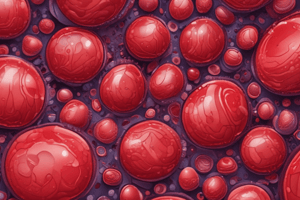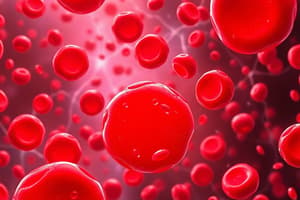Podcast
Questions and Answers
What is the primary function of platelets in the body?
What is the primary function of platelets in the body?
- Producing red blood cells
- Facilitating blood clotting (correct)
- Removing waste products
- Transporting oxygen
How long do platelets typically survive in the body?
How long do platelets typically survive in the body?
- 20 days
- 30 days
- 10 days (correct)
- 3 days
What is the primary function of arteries in the circulatory system?
What is the primary function of arteries in the circulatory system?
- Producing new blood cells
- Carrying deoxygenated blood to the heart
- Carrying oxygenated blood from the heart (correct)
- Removing waste products from the body
What can be done to address low numbers of blood cells in the body?
What can be done to address low numbers of blood cells in the body?
Which of the following is NOT a function of blood mentioned in the text?
Which of the following is NOT a function of blood mentioned in the text?
What is the primary function of red blood cells (RBCs)?
What is the primary function of red blood cells (RBCs)?
Which component of blood accounts for approximately 60% of its volume?
Which component of blood accounts for approximately 60% of its volume?
What is the lifespan of a red blood cell?
What is the lifespan of a red blood cell?
Which of the following is NOT a component of plasma?
Which of the following is NOT a component of plasma?
What percentage of the blood volume is made up of white blood cells?
What percentage of the blood volume is made up of white blood cells?
Which of the following is NOT a type of white blood cell mentioned in the text?
Which of the following is NOT a type of white blood cell mentioned in the text?
Study Notes
Understanding Blood
Introduction
Blood plays a crucial role in the functioning of the human body. It carries essential nutrients and oxygen to all parts of our bodies and removes waste products such as carbon dioxide. Blood is made up of various components including blood cells and plasma, which perform specific tasks to maintain the health and function of the body. In this article, we will explore the composition of blood, its transportation within the body, and the consequences of low numbers of blood cells.
Components of Blood
Plasma
Plasma, the straw-colored top layer, accounts for approximately 60% of blood. It is mostly water, but it also contains proteins, hormones, antibodies, enzymes, and waste products.
Red Blood Cells (RBCs)
RBCs, also known as erythrocytes, are disc-shaped cells responsible for carrying oxygen from the lungs to the rest of the body. They make up about 45% of the volume of blood. RBCs contain hemoglobin, a protein that binds to oxygen, turning the blood red when oxygenated. Each RBC has a lifespan of 120 days and is produced in the bone marrow.
White Blood Cells (WBCs)
White blood cells, or leukocytes, help fight infections and are part of the immune system. They form about 0.1% of the blood volume. There are three main types of white blood cells: lymphocytes, monocytes, and granulocytes. These cells are produced in the bone marrow and other organs such as the spleen, thymus, and lymph nodes.
Platelets (Thrombocytes)
Platelets, small oval-shaped cells, are responsible for blood clotting. They work with proteins called clotting factors to prevent bleeding. Platelets have a lifespan of 10 days and are continuously replaced by new ones produced in the bone marrow.
Blood Travel in the Body
Blood travels throughout the body via the circulatory system, which includes arteries and veins. Arteries carry oxygenated blood from the heart to tissues, while veins return deoxygenated blood to the heart for re-oxygenation. When someone has low numbers of blood cells, medicine can be used to stimulate blood cell production or blood transfusions can be given to replace the missing cells.
Conclusion
Blood is a vital fluid that serves numerous functions in the human body. Understanding its composition, transportation, and the consequences of low numbers of blood cells helps us appreciate its importance and significance in maintaining our overall health.
Studying That Suits You
Use AI to generate personalized quizzes and flashcards to suit your learning preferences.
Description
Explore the composition of blood, including plasma, red blood cells, white blood cells, and platelets. Learn about the role of blood in transporting oxygen and nutrients throughout the body and how low numbers of blood cells can impact health.




